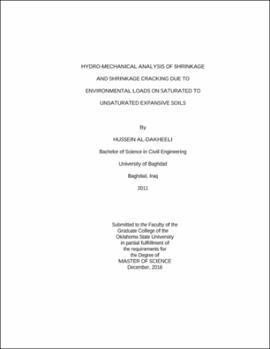| dc.contributor.advisor | Bulut, Rifat | |
| dc.contributor.author | Al-Dakheeli, Hussein | |
| dc.date.accessioned | 2018-06-25T16:31:26Z | |
| dc.date.available | 2018-06-25T16:31:26Z | |
| dc.date.issued | 2016-12-01 | |
| dc.identifier.uri | https://hdl.handle.net/11244/300313 | |
| dc.description.abstract | The volumetric strain of expansive soils due to the change of water content has a significant importance in geotechnical and geoenvironmental engineering. The volumetric strain occurs due to the development of the effective stress in the soil. Expansive soils swell in wet seasons and shrink in dry seasons. In the field, soil shrinkage causes vertical settlement and cracking. It is widely accepted that cracks occur when the lateral tensile stress exceeds the soil tensile strength. The tensile stress is induced from the restraint conditions of the soil shrinkage. When the soil is subjected to desiccation, its hydraulic properties (e.g. water content, hydraulic conductivity) change. The variations of the soil hydraulic properties can also vary its mechanical behavior (e.g. effective stress, strength, fracture tendency). The variation of the soil hydro-mechanical behavior makes studying the shrinkage and cracking a difficult task. In addition, due to the complexity of the physicochemical interactions taking place in the soil particles-water system, predicting the effective stress that causes the volumetric strain in the soil is very challenging. Soil suction has been widely used to characterize the hydro-mechanical behavior. In this thesis, soil suction is vitally employed to study the soil shrinkage and shrinkage cracking. That is achieved by studying: i) the factors that influence the volume change due to the change of suction, and ii) the soil cracking behavior from the stress and strain developed in the soil during the desiccation. To fulfill that, comprehensive literature review and experimental tests have been undertaken. The experimental tests involve subjecting soils with different plasticity indices and preparation conditions to air drying to induce shrinkage and cracking in the soils. That is conducted using the restrained ring testing method. In this test, the stress is measured using strain gauges while the shrinkage (strain) is predicted using the digital image processing. The results emphasize that the crack initiates at a stage very close to the air entry value or the end of the normal shrinkage zone. Further, the results also indicate that a soil can develop similar internal stresses prior to cracking for various initial water contents. | |
| dc.format | application/pdf | |
| dc.language | en_US | |
| dc.rights | Copyright is held by the author who has granted the Oklahoma State University Library the non-exclusive right to share this material in its institutional repository. Contact Digital Library Services at lib-dls@okstate.edu or 405-744-9161 for the permission policy on the use, reproduction or distribution of this material. | |
| dc.title | Hydro-mechanical Analysis of Shrinkage and Shrinkage Cracking Due to Environmental Loads on Saturated to Unsaturated Expansive Soils | |
| dc.contributor.committeeMember | Yang, Xiaoming | |
| dc.contributor.committeeMember | Soliman, Mohamed | |
| osu.filename | AlDakheeli_okstate_0664M_14929.pdf | |
| osu.accesstype | Open Access | |
| dc.description.department | Civil Engineering | |
| dc.type.genre | Thesis | |
| dc.type.material | text | |
